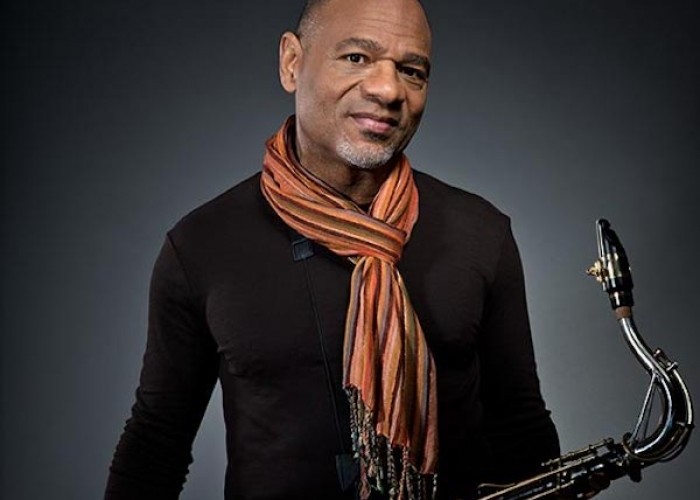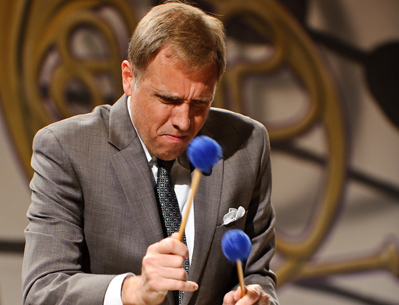Dec 9, 2025 12:28 PM
In Memoriam: Gordon Goodwin, 1954–2025
Gordon Goodwin, an award-winning saxophonist, pianist, bandleader, composer and arranger, died Dec. 8 in Los Angeles.…

Kirk Whalum’s most recent leader date is Humanité (Artistry/Mack Avenue).
(Photo: Anna Webber)During his four-decade career, Grammy-winning saxophonist Kirk Whalum has played numerous genres of music, infusing it all with his gospel and Memphis-soul roots. As a collaborator, he was worked with such high-profile artists as Whitney Houston, Marcus Miller, Bob James and Quincy Jones.
His latest leader album, Humanité (Artistry/Mack Avenue), was recorded in Paris, Tokyo, Johannesburg and other cities around the world with an international cast of supporting players and a theme of global peace.
For his first Blindfold Test, Whalum listened to unidentified tracks that were sent to him online. He commented on the music via Zoom from his home studio in Memphis, where he was on lockdown with his family and working on a Christmas album with British producer/trumpeter James McMillan.
“Rent Party” (The Road From Memphis, Anti-, 2011) Jones, organ; Dennis Coffey, guitar; Kirk Douglas, guitar; Owen Biddle, bass; Stewart Killen, percussion; Ahmir “Questlove” Thompson, drums.
Let me think. I wouldn’t say Joey D. because by [now] he would’ve been playing a lot of notes. [after] Oh, really? ... What I know so well of his, he played 50 years ago. I’ve had a chance to hang with [Jones] a little bit. I was CEO of the Stax Museum and Stax Music Academy for a couple of years. We had a chance to host him.
Growing up in Memphis, in terms of radio, is a singular experience. To us, that was the world. I heard Hank Crawford a lot more than probably the average person did, because this is Memphis. I just thought everybody played like that, so that’s how I tried to play. And that’s the same with Stax Records and Stax artists, and for sure Booker T.; “Green Onions”—my mom played that every Saturday as she cleaned up.
Keiko Matsui
“Light In The Rain” (No Borders, MCA, 1990) Matsui, keyboards; Eric Marienthal, saxophone; Nathan East, bass; Carlos Vega, drums; Paul Jackson Jr., guitar; Bill Armstrong, trumpet; Steve Holtman, trombone; Derek Nakamoto, synthesizer; Lenny Castro, percussion; Michael Fisher, percussion.
That’s Paul Jackson Jr. on guitar. There’s a crispness and peculiarity to his sound that you can hear. And he has a melodic approach, too, that’s telltale. Sounds like Dave Koz? Everette Harp? Wow, OK. Michael Paulo?
I give—that’s my three. [Hint: The keyboard player was featured on your last album] Keiko? With Keiko, oh, man, it’s hard to put my finger on. But there’s a purity and a benevolence to her music. It just washes over you. Sometimes in jazz, what we consider to be impressive or badass, sometimes it’s a ruse. What’s really effective—and what’s really beautiful and impactful, I should say—is something that comes straight from the heart.
Christian McBride’s New Jawn
“The Middle Man” (Christian McBride’s New Jawn, Mack Avenue, 2018) McBride, bass; Josh Evans, trumpet; Marcus Strickland, tenor saxophone; Nasheet Waits, drums.
That [saxophonist] could be a lot of people. That sounds like Christian on bass. Chris Potter on tenor? [after] OK, I wouldn’t have known [Strickland’s] playing. Very cool, though. At least I got Christian. There’s a certain kind of something he does. It’s the way he plays time. There’s a hump. He’s pushing along in a certain way that he kind of doesn’t need the drummer. It’s a lovely gig for drummers to play with him. They’re like, “Oh, he’s got the time. I’ll just have fun.”
I’ve worked with [Christian] a lot. The first time I worked with him, Bob James and I did a record called Joined At The Hip. Then he and I toured together with the Mack Avenue SuperBand.
Christian is like Miles and so many others, like Marcus Miller, who legitimizes the broader contextualization of what it is to be a great musician.
Bill Charlap/Elvis Costello/Joe Lovano
“My Flame Burns Blue” (Billy Strayhorn: Lush Life, Blue Note, 2007) Costello, vocal; Charlap, piano; Lovano, tenor saxophone.
I was gonna say Kurt Elling, but he wouldn’t have been using that much vibrato. It’s a recent recording, I’m gonna say that. It’s not legacy. [On saxophone], my first guess is … Joe Lovano. Who’s the singer? [after] Oh, I never would have guessed that.
Wayne Shorter
“Ponta de Areia” (Native Dancer, Columbia, 1975) Shorter, soprano saxophone; Milton Nascimento, vocals; Jay Graydon, guitar; Herbie Hancock, piano; Wagner Tiso, organ, electric piano; Dave McDaniel, bass; Roberto Silva, drums.
Brazilian singer. Gilberto Gil? Ivan Lins? It’s an older track, and I’ve heard it before. [listens more] So, that’s Wayne Shorter.
What’s the name of that song? Got it. Beautiful. That made my day, actually. When I was in college, listening to him at Texas Southern in Houston—where Ronnie Laws and Wilton Felder and so many great musicians went—the exemplar at that point in my development was Sonny Stitt. If you can play like Sonny Stitt, you’re good.
But then here’s Wayne Shorter playing kind of off the beat and sometimes out of tune. And why is it that we love him? And I began to figure it out. Having great technique is its own gift. I think it’s important to put those things in perspective. Hearing Wayne Shorter, really hearing him and understanding a little bit more what his gift is, freed me to just be who I am.
Cannonball Adderley Quintet
“You’re A Weaver Of Dreams” (Cannonball Adderley Quintet In Chicago, Mercury, 1959) Adderley, alto saxophone; John Coltrane, tenor saxophone; Wynton Kelly, piano; Paul Chambers, bass; Jimmy Cobb, drums.
That’s Coltrane. Wynton Kelly. [Coltrane] was always pleasantly sharp. Just right on top of the pitch. How beautiful. Trane—God bless him. I was able to tour his house [in High Point, North Carolina] about two months ago. In fact, the last day I was out on tour before the pandemic, I was in High Point, and I took pictures in his house. It’s not open yet to the public, so it was a privilege for me to go in there. DB
This story originally was published in the August 2020 issue of DownBeat. Subscribe here.

Goodwin was one of the most acclaimed, successful and influential jazz musicians of his generation.
Dec 9, 2025 12:28 PM
Gordon Goodwin, an award-winning saxophonist, pianist, bandleader, composer and arranger, died Dec. 8 in Los Angeles.…

Belá Fleck during an interview with Fredrika Whitfield on CNN.
Jan 13, 2026 2:09 PM
The fallout from the renaming of the John F. Kennedy Center for the Performing Arts to include President Donald…

Flea has returned to his first instrument — the trumpet — and assembled a dream band of jazz musicians to record a new album.
Dec 2, 2025 2:01 AM
After a nearly five-decade career as one of his generation’s defining rock bassists, Flea has returned to his first…

Dec 11, 2025 11:00 AM
DownBeat presents a complete list of the 4-, 4½- and 5-star albums from 2025 in one convenient package. It’s a great…

Vibraphonist Chuck Redd found himself in the midst of a political firestorm after canceling his gig Dec. 24 at the newly renamed Trump Kennedy Center.
Jan 6, 2026 2:32 AM
The Board of Trustees at Washington, D.C.’s Kennedy Center for the Performing Arts voted on Dec. 18 to rename the…